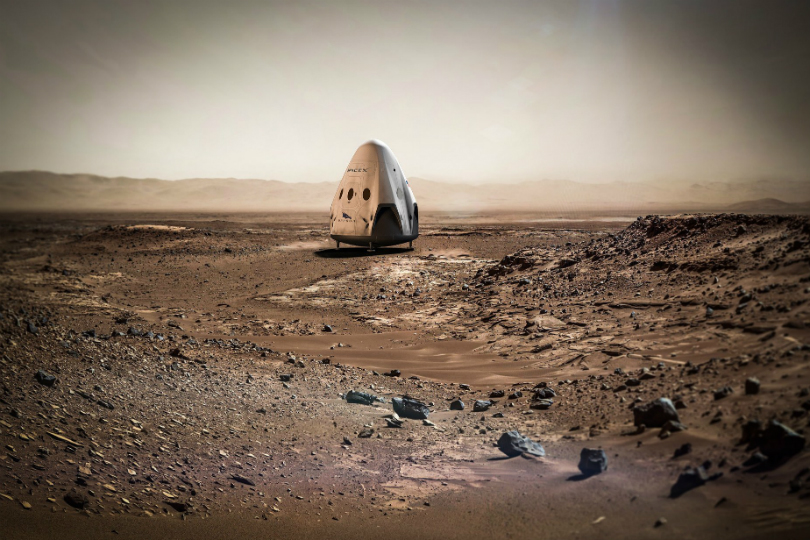
It’s List Season.
Today, it’s all about science and the great things white-coats accomplished in 2016.
Still with a whole other month to go, humans have managed to conceive a baby that has three parents, give coffee the all-clear and note we all got a bit fatter. Thanks, science.
- 1 Coffee doesn’t give you as much cancer as sausages
- 2 We can edit genes to fight cancer, but not HIV
- 3 Einstein was smart
- 4 Monkey head swap
- 5 Brains
- 6 We may have found life on Mars
- 7 And we may have found a way to get there – fast
- 8 Where did we come from?
- 9 Robots began really freaking us out
- 10 Building houses out of carbon dioxide
- 11 The first hands-free death was recorded
- 12 Space got stranger
- 13 We’re gonna need a bigger table
Coffee doesn’t give you as much cancer as sausages
Coffee, the browned juices of that naughty bean which has divided society for 500 years, finally got a reprieve. In June, the World Health Organisation downgraded its warning on a potential link between coffee and cancer. Almost. While the WHO dismissed a specific link between coffee and cancer, it did recognise the chance of hot drinks – over 65C – being “probably carcinogenic”. So stick to your Farmers Union.
We can edit genes to fight cancer, but not HIV
You would have CRISPR on 2014’s list. They’re short sections of DNA found in bacteria which were a big deal when discovered was because the bacteria use a protein called Cas9 like a pair of “scissors” to cut out pieces of an invading virus’s DNA. They then incorporate that into their own genomes so they can recognise the enemy in future. Learning how to wield the Cas9 scissors means we can edit genes and there’s been some amazing success in areas such as curing leukaemia.
On one hand, don’t hold your breath waiting for CRISPR to make you and your kids immortal. It’s bang in the middle of a patent war, and that generally means, for a long time, it’s only going to be good for wealthy people prepping their immortal retirement in Elysium.
On the other hand – China! It doesn’t care about patents and clinical trials and nonsense. In November, a Chinese team altered cells using the CRISPR gene-splicing technique, then injected them into an adult in the hope they will fight off a type of lung cancer. We’re still waiting on the results, but it’s the same technique Silicon Valley legend Sean Parker invested $US250 million in when setting up the Parker Institute. The group of University of Pennsylvania researchers it funded hoped to be the first to get the CRISPR technology into humans.
Another gene-editing technique, HITI, partially restored vision in blind animals.
And Canadian scientists also had a pop, trying to edit out HIV. But they made it stronger instead.
Einstein was smart
We found a new way to study the universe. Only it wasn’t exactly new, because Albert Einstein found it 100 years ago. It’s taken us that long to actually build an instrument that can detect gravitational waves, ripples in the universe that contract and expand the spacetime around them.
It’s “off the scale huge”, according to Clifford Burgess, a theoretical physicist at McMaster University in Hamilton, Canada. A Nobel Prize is all but guaranteed for the team at the Laser Interferometer Gravitational-Wave Observatory (LIGO), which includes a couple of Aussies. They’ve already watched a couple of black holes bump into each other – twice.
Monkey head swap
We said “biggest” stories, not “most responsible”. That means we can talk about the dark world of head-swap operations and the fact they’re actually a thing in science now. Next year, surgeon Sergio Canavero claims he will give spinal muscular atophy sufferer Valery Spiridonov an entirely new body.
Can he do it? Incredibly, maybe. In January, a team at the Konkuk University School of Medicine in South Korea released a video of mice sniffing and moving their limbs a couple of weeks after having their spinal cords severed at the neck and re-fused.
“Therefore I guess it is possible to reconnect the [spinal] cord after complete severance,” C-Yoon Kim says. Cue grim fascination. Much more impressive was Ohio State University researchers giving a quadriplegic man a brain implant so he could play Guitar Hero.
Brains
While we’re talking about lopping off heads, a group called 21st Century Medicine froze an entire rabbit brain intact. MIT graduate Robert McIntyre led a team that suspended the poor bunny’s neurons and synapses with strong chemicals, then chilled them.
A peer review panel then checked it all out with an electron microscope and gave the rabbit brain the all clear – “Every neuron and synapse looks beautifully preserved across the entire brain.”
That gives hope to every terminally ill person and filthy rich eccentric the world over. For McIntyre, some big kudos and about $35,000 in prizemoney for winning a five-year long competition to see who could do it.
If you want to live longer, play golf instead. It will extend your time on Earth by five years.
We may have found life on Mars
Finally, we found some evidence Mars might have sustained some form of life. This one started way back in 2008 when NASA’s Spirit rover found a mineral called Opaline Silica inside the Gustav crater. On the silica were tiny growths that looked like little cauliflowers.
Then in December last year, a couple of astronomers found evidence in a Chilean desert that those “cauliflowers” might have been sculpted by microbes.
And in September this year, another team found that Mars had large lakes of liquid water much longer than previously thought. That meant those microbes had more time to form and survive in Mars’ “relatively warm, wet climate” for up to 700 million years.
Oh, we also found oxygen. That’s kind of a big deal, too, because Elon Musk came up with a plan to get humans there by 2018. Another private consortium is just aiming for space first, inviting regular folk to come aboard the future mining nation stateship Asgardia.
And we may have found a way to get there – fast
In 1999, British inventor Roger Shawyer came up with a design for an engine that produces virtually no thrust at all. It’s known as the “EM Drive”, and physicists the world over don’t want to know about it, because if it works, Newton’s third law gets chucked in the bin. That’s the famous one that says “For each action there’s an equal and opposite reaction”.
The conundrum is, if it works, we might also be able to get to Mars in a matter of hours, rather than years. That tiny bit of thrust means a lot in space and it can pretty much be generated by shining a laser.
Here’s the big news – in November, after 17 years, NASA’s Eagleworks Laboratory team had its EM Drive test results accepted in the American Institute of Aeronautics and Astronautics’ (AIAA) peer-reviewed Journal of Propulsion and Power. And the arguments have been raging ever since.
Where did we come from?
We found the 4 billion year old ancestor of all living things.
Its name is Luca, and it ate hydrogen and metal. But not everyone appreciated the idea of life beginning in deep sea vents, so the jury’s still out on whether Luca actually is the “last Universal Common Ancestor”.
And for the first time, a human baby was born to three parents.
Robots began really freaking us out
In March, Google’s AI bot AlphaGo beat world champion Lee Sedol 4-1 in a five-match series at Go – a game with more board positions than there are atoms in the universe. There were moments where AlphaGo didn’t just outmanouevre Sedol – its onlookers could almost see it learning on the spot. David Ormerod wrote that watching AlphaGo’s Game 3 win made him feel “physically unwell”.
Deep Mind, the Google arm whose AI powers AlphaGo, thinks AlphaGo’s intuition could manage the UK’s power grids. How about no?
And Boston Dynamics, Google’s other frighteningly competent bot project, made some tweaks to its ATLAS robot so it can walk through snow and not be pushed around by humans:
Google bought the robotics company in 2013 and is kind of now wishing it hadn’t.
Building houses out of carbon dioxide
Scientists in Iceland found a way to capture global warming enemy CO2 in rocks. They pumped it into volcanic rock, of which there is plenty in Iceland, and found something incredible.
The basalt turned into carbonate minerals, which then turned into limestone, which trapped the CO2. That’s a process which when occurring naturally, takes about a couple of hundred thousand years.
The team combined from Columbia University, University of Iceland, University of Toulouse and Reykjavik Energy, showed it can be done in two years.
You can even build your house from the new rock.
The first hands-free death was recorded
2016 was the year of the autonomous car. You weren’t in the auto game if you didn’t either release a hands-free option, or released plans to release one by 2021.
Unfortunately, or inevitably, pack leader Tesla became the first car-maker to be linked with a fatality due to someone using autopilot mode.
Space got stranger
Conspiracy theorists enjoyed the biggest “I told you so” of their lives and everyone else was a bit gobsmacked when scientists admitted a ninth planet could be hiding in our solar system.
The tinfoil hatters love to think it’s Nbiru, the home planet of the Anunnaki, who enslaved humans and played genetics with them thousands of years ago. When they return, it will be riding Nbiru directly into the Earth and destroying it. It could happen as soon as next Wednesday. Yikes!
That’s unlikely, because “Planet X”, if it exists, would be between 2-15 times the size of Earth and could orbit the Sun once every 15,000 years, putting it 240,000,000,000km away. So, hard to miss.
And then there was the weird planet sending “alien” messages to Earth. We found out more about that – it’s even weirder than we thought.
We’re gonna need a bigger table
Finally, we added four elements to the Periodic Table – nihonium, moscovium, tennessine, and oganesson. Or, if you prefer, Nh, Mc, Ts and Og.
Nihonium – was discovered in Japan, where “Nihon” means “Japan”.
Moscovium – was discovered in Moscow
Tennessine – was discovered in Tennessee. (See a pattern yet?)
Oganesson – recognises transactinoid elements legend Professor Yuri Oganessian
Four.
That’ll do, science. That’ll do.






















Awesome article on scientific stuff
Very interesting article as usual :.)
Wow…impressed 🙂
Awesome article on scientific stuff